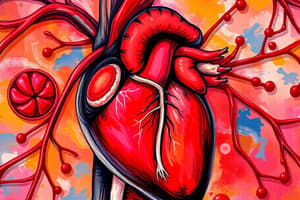Podcast
Questions and Answers
What is the role of hematopoietic cells in the angioblastic blood islands during early embryonic development?
What is the role of hematopoietic cells in the angioblastic blood islands during early embryonic development?
Hematopoietic cells give rise to the blood cell lines.
Describe the sequential migration path of cardiac progenitor cells during heart tube development.
Describe the sequential migration path of cardiac progenitor cells during heart tube development.
Cardiac progenitor cells migrate first to form the cranial segments, then progress to the caudal portions such as the right and left ventricles.
What contributes to the formation of the epicardium in the developing heart?
What contributes to the formation of the epicardium in the developing heart?
The epicardium develops from cells that migrate over the myocardial mantle from adjacent areas.
Explain the significance of the cardiac jelly in the endocardial heart tube.
Explain the significance of the cardiac jelly in the endocardial heart tube.
How do the bilateral endocardial heart tubes transform during embryonic development?
How do the bilateral endocardial heart tubes transform during embryonic development?
What are the main components of the developing heart tube during the fourth week of gestation?
What are the main components of the developing heart tube during the fourth week of gestation?
What is the significance of the bulbus cordis and ventricle growing faster than other regions of the heart tube?
What is the significance of the bulbus cordis and ventricle growing faster than other regions of the heart tube?
Describe the venous drainage system in the developing heart tube and its components.
Describe the venous drainage system in the developing heart tube and its components.
What change occurs to the atrium and sinus venosus during the formation of the S-shaped cardiac loop?
What change occurs to the atrium and sinus venosus during the formation of the S-shaped cardiac loop?
List the five main dilatations of the primitive heart tube and their order.
List the five main dilatations of the primitive heart tube and their order.
Flashcards are hidden until you start studying
Study Notes
Atrioventricular Valves
- Atrioventricular (AV) valves form from endocardial cushions made of mesenchymal tissue.
- Bloodstream action hollows and thins tissue on the ventricular surface, which remains attached to the wall by muscular cords.
- Muscular tissue in these cords degenerates, replaced by dense connective tissue.
- Resulting valves are connective tissue covered by endocardium.
- Left AV canal features two valve leaflets known as the bicuspid or mitral valve.
- Right AV canal forms three valve leaflets, constituting the tricuspid valve.
Septum Formation in the Heart
- Septa divide the chambers of the heart for proper circulation.
- Muscular interventricular septum, membranous interventricular septum, and septa in the conus cordis (bulbar septa) are crucial components.
- The truncus arteriosus is segmented into the ascending aorta and pulmonary trunk.
Blood Islands and Heart Tube Development
- In the third week of gestation, angioblastic blood islands emerge in the yolk sac and chorion.
- Inner blood island cells become hematopoietic cells, while outer cells form endothelial layers of blood vessels.
- Blood islands coalesce to form blood vessels, essential for nutrient supply to the embryo.
- Cardiac progenitor cells in the epiblast near the primitive streak migrate to form different heart regions.
- Cranial segments (outflow tract) migrate first, followed by right ventricle, left ventricle, and sinus venosus.
Formation of the Endocardial Heart Tubes
- Blood islands in the splanchnic mesoderm develop into a vessel plexus forming paired endocardial heart tubes.
- Splanchnic mesoderm proliferates into the myocardial mantle, leading to myocardium development.
- The epicardium arises from migrating cells over the myocardial mantle from adjacent regions known as the cardiogenic field.
Fusion of Heart Tubes
- The endocardial heart tubes merge due to embryonic growth, forming a single heart tube by the fourth week of gestation.
- The tube is suspended in the pericardial cavity by the dorsal mesocardium and consists of an inner endothelial lining and an outer myocardial layer.
- Venous drainage occurs at the caudal pole, starting the pumping action toward the dorsal aorta at the cranial pole.
The Cardiac Loop Formation
- Beginning on day 21, the primitive heart tube experiences expansions (dilatations) and constrictions.
- Key dilatations include truncus arteriosus, bulbus cordis, primitive ventricle, primitive atrium, and sinus venosus.
- The bulbus cordis and ventricle grow quickly, forming a U-shaped bulboventricular loop by the end of the fourth week.
- The atrium and sinus venosus move behind the truncus arteriosus and bulbus cordis, resulting in a S-shaped cardiac loop.
Connections to Intra-embryonic Vessels
- At the venous end of the heart tube, sinus venosus receives three significant veins:
- Vitelline vein from the yolk sac,
- Umbilical vein from the placenta,
- Common cardinal vein from the body wall.
Studying That Suits You
Use AI to generate personalized quizzes and flashcards to suit your learning preferences.




